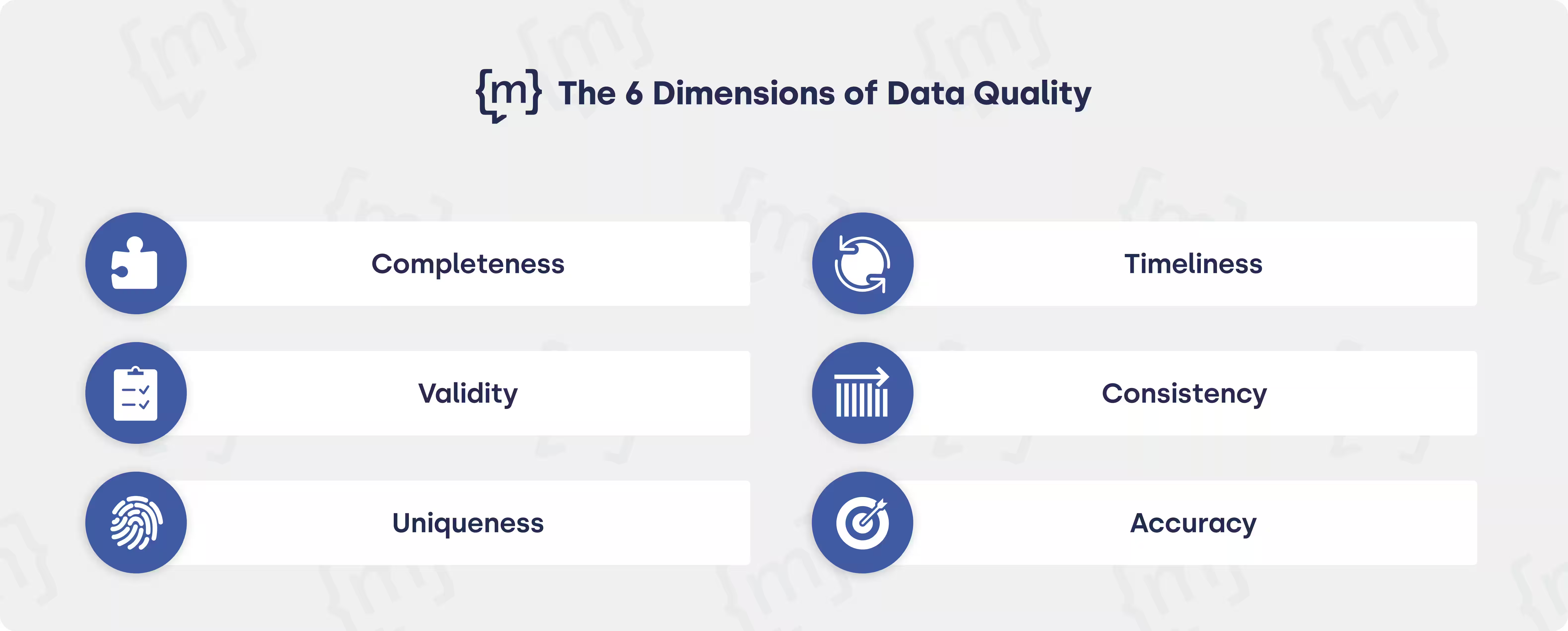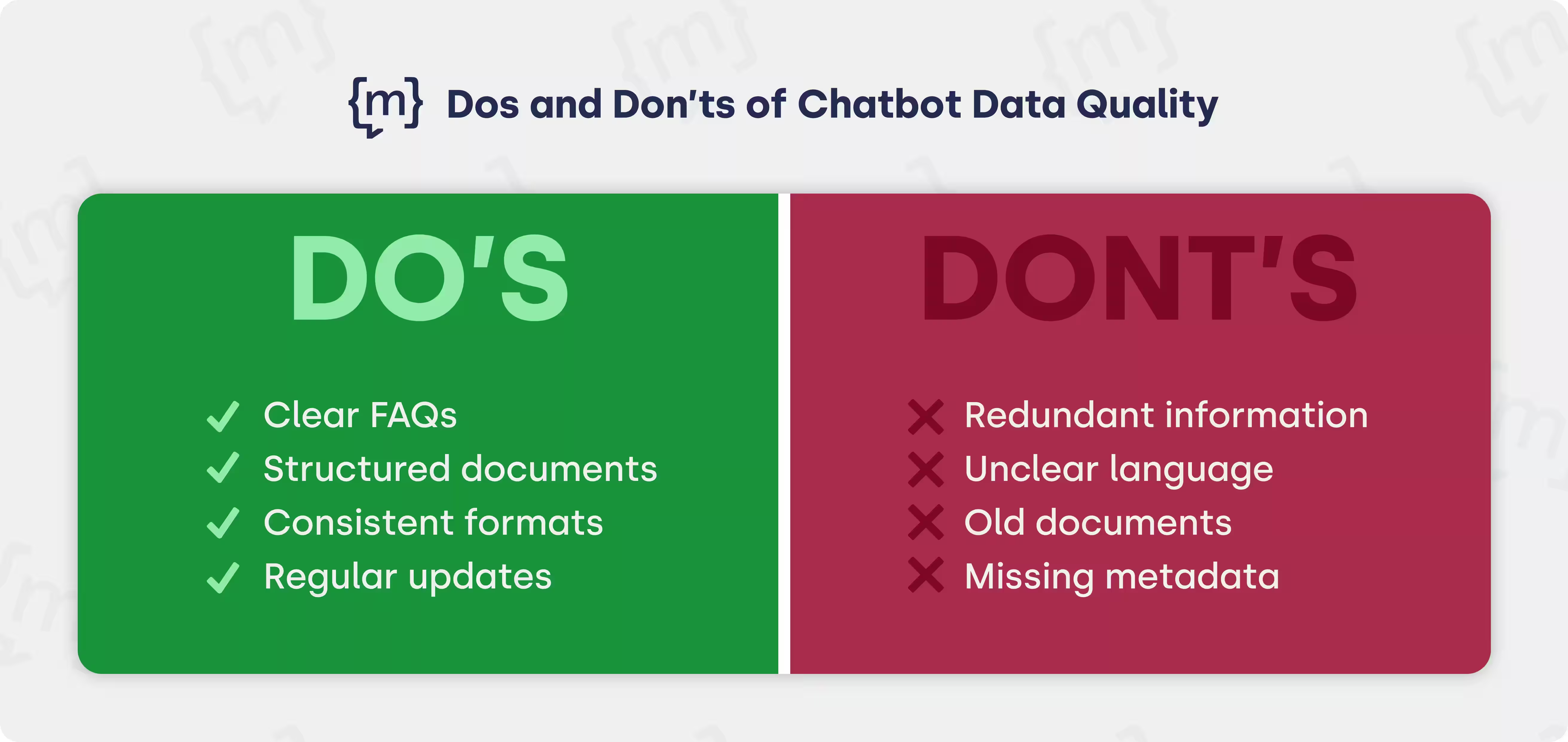Why is Data Prepreprocessing crucial?
Data preprecessing, or data preparation, involves transforming raw data into usable information so that the AI's large language model can be used to its full potential. It requires structured and up-to-date data that is highly relevant for answering queries.
Important to know: LLMs only work as well as the information they are fed. The quality of the data directly determines the quality of the responses. The problem here is the rapidly growing amount of data and data sources available today. There is a vast amount of data available, but not all of it is of equal quality and should be used for and by AI. This also applies to the AI behind chatbots. Poorly maintained data is responsible for poorer chatbot performance. In some cases, misunderstandings can arise due to incorrect responses or outdated data being output. This leads to declining user satisfaction and, in the worst case, customer churn.
Simply put: “Garbage in, garbage out.” If the database is not correct, even the best model cannot deliver good performance.
Data Preprocessing for AI
The process of data preparation is often referred to as data preprocessing, traditionally an important step in data analysis. In recent years, the underlying techniques have been adapted to specifically train AI models. The process basically comprises several steps, including the
- Collection,
- Cleaning,
- Structuring, and
- Formatting of content.
Data cleansing involves identifying and correcting errors or inconsistencies in the data. A classic example of this is duplicate entries, which are eliminated. The more clearly structures are defined, the better AI can recognize correlations. Uniform formats facilitate processing and maintenance. The data is then finally checked and approved before it can be used as a training basis for AI. Here is an overview of the process:

If these steps are carried out regularly within the company and the database is checked and optimized, a significant improvement in data quality can be achieved. The model can then process reliable content and output it accurately and tailored to requirements. This strengthens user confidence in the system.
Why Data Quality is particularly important
In a study by Alteryx on the work of data analysts in the age of AI, almost half of data analysts (46%) stated that the biggest challenge in data preparation lies in quality issues. (Alteryx, 2025) The data to be analyzed is also becoming increasingly complex, which increases the time required for overall data management. How can high-quality data be ensured within a company? High-quality data is created when all relevant information is captured completely and up-to-date and is valid and unambiguous according to defined rules. In addition, it must remain consistent across all systems and accurately reflect reality. Processes, responsibilities, and technical standards must be clearly defined. This includes regularly reviewing and updating data to meet all six dimensions of data quality:

It is particularly important for the successful use of AI that the data used meets these criteria. Before introducing a chatbot, for example, it should be checked whether the underlying information meets the criteria of accuracy, completeness, consistency, timeliness, uniqueness, and validity. In the next section, we will show how these principles can be implemented in practice, with specific best practices for building and maintaining an AI chatbot.
Resource Management with the Knowledge Base
The knowledge base is the “brain of AI” and can include various formats, including documents (PDF, DOC), web pages, question-answer pairs, or structured CSV files, and serves as a single source of truth for AI. Best practices for an effective knowledge base include:
- Clearly and concisely worded FAQs so that the AI can clearly assign questions
- Instead of “How much does the product cost?” That depends on many factors. Better: “The product costs $29 per month for the basic plan.”
- Avoiding redundant content to prevent conflicting answers
- Instead of checking two FAQ entries with different prices, ensure that there is a uniform, centrally maintained source.
- Use common formats for documents so that they can be processed reliably
- Short paragraphs, clear headings, uniform columns in CSV files
- Create question-answer pairs for important topics to make particularly relevant information directly available
- Important topics in customer inquiries are usually prices, delivery times, or support. Example: “Can I get a refund?” → “Refunds are possible 14 days after purchase with invoice.”
- Regular maintenance and updating of content to ensure the relevance and timeliness of data
- Integration of monitoring and feedback to identify and continuously close knowledge gaps
Each source should be checked and only used live after approval. Modern systems such as RAG (Retrieval Augmented Generation) make it possible to retrieve specific relevant content and thus provide accurate answers even with large amounts of data. Which formats are best suited for the knowledge base? Certain formats should be preferred for each resource type (PDF, website, document, Q&A, CSV).
CSV Files
CSV files are ideal for structured data. The better structured the CSV file is, the more accurately the AI can read it. Therefore, there are a few points to consider when importing:
- Use consistent separators: Each CSV row is divided into individual fields using the selected separator (e.g., semicolon “;” or comma “,”)
- Clearly define the title row: The unique title row clearly names the columns so that the chatbot can interpret the data correctly. Without a clearly defined headline with categories, it may even be the case that the CSV upload does not work at all
- Pay attention to data volume and field length: Short, concise fields improve accuracy
PDF Files
CSV files are unsuitable for importing complex content or articles. For this use case, document resource types, usually in PDF format, offer the necessary depth of detail and context. Here, too, there are a few aspects to consider:
- Ensure machine readability: PDFs should contain real text, not just scans or images, as these cannot be read
- Structured PDFs: Outlines, headings, paragraphs, and lists help AI process content in a meaningful and targeted way
- Check for updates: PDFs must be updated regularly so that the chatbot does not output outdated information.
Websites
Websites offer dynamic content and are often a good addition when current information is needed, e.g., for news, product pages, or support articles. Best practices here:
- Define the scraping interval: It must be ensured that the page can be scraped well. Most scrapers cannot read JavaScript content, for example. The content should also be updated at regular intervals (e.g., 7/14/30 days), known as the scraping interval
- Select relevant pages: Only resources with relevant content should be considered
- Structure and formatting: HTML structure (headings, paragraphs, lists) makes it easier for AI to extract relevant text.
A clean database is by no means a “nice-to-have,” but rather a key success factor. Only when the training and knowledge data are clean, consistent, and up-to-date can the chatbot provide reliable answers and exploit the full potential of its AI. As an experienced partner for the use of AI chatbots in companies, moinAI offers many resources to help you. Our CSM team has summarized tips on the topic, formats, and data, and what is best suited for AI chatbots in the Help Center.
Tips for the Data Preparation for an LLM
When training LLMs and agent systems, AI benefits from llm.txt files, which link to related Markdown documents like extended sitemaps, thereby filtering out unnecessary HTML/JS content. RAG systems draw on the same structured sources, extract relevant excerpts, and use clearly structured documents for processing in manageable “chunks,” i.e., smaller excerpts. In addition, an MCP server can be helpful for centrally managing content and controlling versions. MCP servers can also be used to control access. The basic principle is that clear structures and high-quality content increase the efficiency and accuracy of LLMs.
Common Errors
Typical errors in handling data arise when content is redundant, unstructured, or even out of date. In addition, the data format may be incorrect. Such problems impair the accuracy and efficiency of AI. The clearer and more structured the knowledge base, the more accurately the AI chatbot, for example, will respond. The aforementioned sources of error can be summarized in two categories.
Unstructured or missing Knowledge
If FAQs or knowledge resources are imprecisely worded or duplicated, this leads to contradictory or confusing answers. Every question should be answered clearly. Long, unstructured documents make it difficult for the chatbot to process. Outdated or irrelevant content impairs the quality of the answers. Provided sources and links should be checked regularly and removed if they are no longer up to date. If there is no suitable resource for certain questions, an AI chatbot will recognize this in most cases. Missing knowledge must then be supplemented by the targeted development of suitable content so that future inquiries can be answered reliably.
Format Errors
The source of the error can often be traced back to the format of the data. In CSV files, columns are often not separated correctly due to inconsistent separators. This can cause the import to fail. Each row must also have the same structure as the title row; irregular lengths lead to errors. Very long content in a column or a large number of columns make processing difficult and increase the chatbot's response time. Superfluous or irrelevant columns should be omitted to reduce the overall amount of data and increase the accuracy of the responses.
Dos for the Data
- Formulate clear FAQs: Precise questions and understandable answers provide the AI with unambiguous information
- Provide structured documents: A logical structure with headings and paragraphs is important
- Use consistent formats: Uniform spellings and data structures facilitate understanding and processing
- Perform regular updates: Content must be continuously maintained and updated.
Don'ts for the Data
- Redundant information: Duplicate or contradictory content leads to confusion and inaccurate answers
- Unclear language: Vague or ambiguous formulations make it difficult for the AI to correctly understand the context
- Outdated documents: Old content should be regularly reviewed and updated
- Neglecting metadata: Without a title, categories, or creation date, the AI lacks the necessary context and may provide incomplete answers.

Conclusion
Due to rapid data growth and the difficulties involved in maintaining data quality, a data-driven approach is crucial for improving business processes and the use of AI. Employees need to understand why data quality is so important and how it can be ensured. After all, good data quality ensures the reliability of operational processes and protects companies from high financial risks caused by data errors. On the customer side, clean data means better responses to user queries, less frustration for customers, and consequently higher customer satisfaction.
Clean, consistent data is essential for the entire company, especially for the work of employees. Incorrect or contradictory information not only leads to incorrect AI results, but also to human errors, for example when there are two different answers to the same question. A solid data foundation therefore requires comprehensive data verification and continuous maintenance of the knowledge base. Only through this ongoing quality process can AI systems be effectively trained and employees be supported efficiently and reliably. This ensures long-term business success.
The AI chatbot from moinAI is a practical solution for this: your data is managed in a structured and clear manner in the knowledge base, avoiding redundant content. Our CSM team has many years of experience in optimally preparing relevant resources for LLMs and RAG systems. This allows our customers to benefit from efficient knowledge management and a significant increase in data quality.
[[CTA headline="Try the moinAI AI chatbot now, customized to your data." subline=“Harness the full potential of modern language models and AI technologies in your company.” button="Try it now!" placeholder="https://hub.moin.ai/chatbot-erstellen" gtm-category=‘primary’ gtm-label=“Try it now!” gtm-id=“chatbot_erstellen”]]



.svg)



